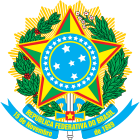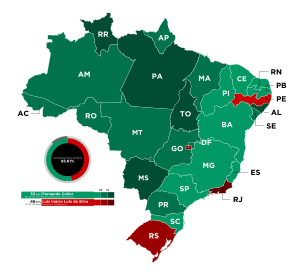| ||||||||||||||||||||||
| Turnout | 88.08% (first round) 85.61% (second round) | |||||||||||||||||||||
|---|---|---|---|---|---|---|---|---|---|---|---|---|---|---|---|---|---|---|---|---|---|---|
| ||||||||||||||||||||||
| ||||||||||||||||||||||
| This article is part of a series on the |
 |
|---|
Presidential elections were held in Brazil in 1989, with the first round on November 15 and a second round on December 17. They were the first direct presidential elections since 1960, the first to be held using a two-round system and the first to take place under the 1988 constitution, which followed two decades of authoritarian rule after the 1964 Brazilian coup d'état.
The collapse of the military-imposed two-party system[1] that pitted the right-wing authoritarian National Renewal Alliance (ARENA) against the catch-all Brazilian Democratic Movement (MDB) resulted in a wide array of new parties seeking to fill the political vacuum. President José Sarney of the PMDB, the MDB's successor, was ineligible to run. Sarney, who was elected Vice President on Tancredo Neves's ticket in the 1985 elections, had taken office due to Neves's death before his scheduled inauguration.[2]
Popular Governor of Alagoas Fernando Collor de Mello resigned from his position to mount a bid for the presidency.[3] Previously a member of the PMDB, Collor joined the small National Reconstruction Party (PRN) in the run-up to the presidential campaign. Collor, who presented himself as a political outsider and was noted for his charisma,[4] polled at a mere 5% according to polling taken in early 1989.[5] Collor's emergence as an unlikely frontrunner was credited to his campaign's skilled use of television advertisements to make the case for his candidacy.[6] Collor, who had governed one of the smallest states in the country, chose Senator Itamar Franco of the populous and electorally crucial state of Minas Gerais as his running mate.[7] Further, Collor's campaign was noted for his relative youth at the mere age of 40.[8]
Following the end of state repression of socialist parties, the Brazilian Left faced a fractured field defined by two primary candidates: Popular labour leader Luiz Inácio Lula da Silva, known as Lula, of the industrial ABC Region of São Paulo,[9] and Leonel Brizola, a longtime staple of the Brazilian Left who had served as Governor of Rio Grande do Sul prior to the 1964 military coup.[10] Lula was widely known in Brazil for his role leading the highly publicized metalworkers' strike in the State of São Paulo during the late 1970s[11] and had been elected a federal deputy in 1986 with the most votes nationwide.[12] Lula ran as a member of the Workers' Party (PT), a left-wing party he helped found in 1980. For his running mate, Lula chose Senator José Paulo Bisol of Rio Grande do Sul, a member of the Brazilian Socialist Party (PSB), to unite the left. In the first round, Lula narrowly defeated Brizola, who was running as a member of the Democratic Labour Party (PDT), for a position in the runoff.[13]
The general election was marked by negative campaigning, with Collor accusing Lula of supporting divisive class struggle.[14] The role of Rede Globo, the largest and most-watched TV network in Brazil, in Collor's election remains controversial.[15][6] Following a tumultuous election cycle, Collor defeated Lula to become the first directly elected President of Brazil in almost thirty years. Collor would later resign from office facing an impending impeachment trial.[16]
- ^ "Bipartidarismo: Sistema vigorou durante a ditadura militar". educacao.uol.com.br (in Brazilian Portuguese). Archived from the original on 2021-01-08. Retrieved 2020-12-01.
- ^ Globo, Acervo-Jornal O. "Sequestro do empresário Abilio Diniz agitou campanha presidencial em 1989". Acervo (in Brazilian Portuguese). Archived from the original on 2021-01-27. Retrieved 2020-12-01.
- ^ "A guerra ao turbante". Abril. Veja.com. 23 March 1988. Archived from the original on 17 March 2009. Retrieved 24 July 2012.
No seu papel de caçador de marajás, o alagoano Fernando Collor de Mello torna-se um dos governadores mais populares do país
- ^ Brooke, James (1992-11-08). "Looting Brazil (Published 1992)". The New York Times. ISSN 0362-4331. Archived from the original on 2021-01-28. Retrieved 2020-12-01.
- ^ Coimbra, Marcos (17 May 2013). "Marcos Coimbra: A "síndrome de Collor", engano recorrente". Viomundo. Archived from the original on 12 May 2015. Retrieved 25 March 2015.
- ^ a b Haroldo Ceravolo, Sereza (2009-11-15). "Relação com a Globo 'ajudou bastante', lembra Collor; senador diz ter pensado, na véspera, que perderia a eleição". Noticias.uol.com.br. UOL. Archived from the original on 2021-01-21.
- ^ "Roadmap to Brazil's presidency: win in Minas Gerais". The Brazilian Report. 2018-08-20. Archived from the original on 2020-07-01. Retrieved 2020-12-01.
- ^ "Fernando Collor De Mello | Encyclopedia.com". www.encyclopedia.com. Archived from the original on 2021-01-27. Retrieved 2020-12-01.
- ^ Ramalho, José Ricardo; Rodrigues, Iram Jácome (August 2018). "Sindicalismo do ABC e a Era Lula: Contradições e Resistências". Lua Nova: Revista de Cultura e Política (104): 67–96. doi:10.1590/0102-067096/104. ISSN 0102-6445. Archived from the original on 2021-01-27. Retrieved 2020-12-01.
- ^ Elizangela (2018-01-21). "Brizola 1989: eleições livres ou golpe?". PDT (in Brazilian Portuguese). Archived from the original on 2021-01-27. Retrieved 2020-12-01.
- ^ Richard Bourne (19 October 2009). Lula of Brazil: The Story So Far. University of California Press. ISBN 978-0520261556.
- ^ "Eleições 2006 – Com votação recorde, Lula chega ao segundo mandato". G1. Grupo Globo. Archived from the original on 4 March 2016. Retrieved 3 October 2010.
- ^ Jacky Picard, ed. Le Brésil de Lula: Les défis d'un socialisme démocratique à la périphérie du capitalisme. Paris: Khartala, 2003, page 81
- ^ Brooke, James (1989-12-13). "Polls Show Brazilian Leftist Candidate Closing Gap as Election Day Nears (Published 1989)". The New York Times. ISSN 0362-4331. Archived from the original on 2021-07-30. Retrieved 2020-12-01.
- ^ Cavgias, Alexsandros; Corbi, Raphael; Meloni, Luis; Novaes, Lucas M. (2023). "Media Manipulation in Young Democracies: Evidence From the 1989 Brazilian Presidential Election". Comparative Political Studies. 57 (2): 221–253. doi:10.1177/00104140231169027. ISSN 0010-4140. S2CID 258937696. Archived from the original on 2023-05-28. Retrieved 2023-05-28.
- ^ "Brazil President Resigns in Wake of Impeachment". Los Angeles Times. 1992-12-30. Archived from the original on 2022-10-24. Retrieved 2020-12-01.



